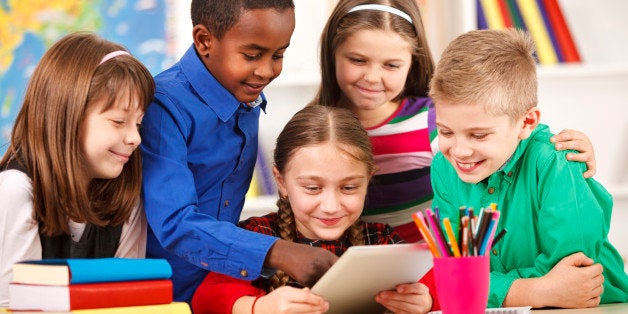
Last week, one of my third graders was sitting on the rug before Morning Meeting and said to his friends, "Girls are like, 'Ooooh, shopping!'" as he flung his hands out dramatically. I stared at him, felt my heart break slightly, and said, "That's sexist. How would you like it if I said, 'Oooh, boys only like cars and video games.' It's not true. It would make you feel bad." That shut him up, but I knew he had not really understood what I was saying. Later in the day at the beginning of Math, another student was taking a really long time to pick his whiteboard marker to use during our lesson. I said, "What's taking so long?" He replied, "Well, the first marker I pulled out of the bucket was pink." I sighed. "What's wrong with that?" I asked, feigning ignorance. "Well, you know..." he trailed off. I simply said, "Get your marker and sit down."
It was difficult for me to realize that my suspicions were true: the kids in my class, even at age eight, had already absorbed so much sexism from our society that it affected the way they perceive and act in the world. I knew something had to be done.
The next day during Morning Meeting, I wrote the word "stereotype" on the whiteboard. I then asked the students if any of them knew what it meant. A few kids raised their hands and said things like "a music system" or "a stereo." One kid said "it has to do with segregation." I defined stereotype for the students as a negative viewpoint that someone has about a specific group of people. I used the example of a white person having a negative perception of black people. The kids were shocked that I was talking about this in class and stared at me with wide eyes.
I then wrote the words "sexism" and "racism" below "stereotype." I explained that sexism and racism stem from negative stereotypes about whole groups of people, like women or people of Latinx heritage. Then, without prompting, the kids started sharing examples of racism and sexism they had faced. More and more hands went in the air after each kid shared. They told us how when they were playing in the street, people would drive by and yell racist remarks. They told us how when they were shopping at the mall and were going to make a purchase, some people looked at them funny. Even the two kids who had said the sexist remarks the day before were active participants in the conversation. One of them told us how there was a girl on his football team and she was the best player. The other told us that there was a girl on his baseball team who was also one of the best. It was as if the kids had been itching to tell these stories for a long time but had never had the words or the opportunity to.
I was in total awe of my kids during this conversation. For the first time ever, I didn't have to tell anyone to stop talking out of turn or to come back to the group; they were more engaged in this discussion than anything else we had done all year. This was about their lives, their reality. I was disappointed when I had to end the conversation to begin our next lesson, knowing that this conversation, this discussion of the racism and sexism that was already plaguing my kids' lives at such a young age, was so much more important.
I concluded the conversation with a series of questions: "Is pink a girl color?" I asked. "No!" my students yelled. "Can boys play with dolls?" I said. "Yes!" they shouted. "Can girls play sports?" I yelled. A resounding "Yes" rung out across the room. I smiled to myself triumphantly as I realized this mini-lesson had been more successful than I had ever imagined. I told the students we would continue to have these conversations as the year went on, and that even though there is a lot of racism and sexism in our society, it will not be tolerated in our classroom.
Later on, the kid who had rejected the pink marker the day before intentionally chose the pink marker to use during Math that day (I swear, I didn't tell him to). That day was the highlight of my year so far. To anyone who thinks that these topics are too heavy for children to talk about: these issues are already affecting them every single day, and pretending that they don't exist is doing the kids a disservice. Only if we do begin having these conversations with kids at an early age, and continue having them, will they grow up to be the kind of socially aware adults who will be able to challenge our existing systems and change them. No matter what some adults may think, children do get it. And educating them about these things early on is the best way to equip them with the tools and language to fight against them in the future so that one day, our kids won't have to worry about racist remarks from strangers when they are simply playing in their backyards.
